Over the past few years, the way auto repair companies are marketed has dramatically changed.
Yellow Pages, radio, TV, print… all of these tactics are basically obsolete. The truth is, no modern business can hope to survive without employing digital marketing.
Online marketing is definitely daunting to newcomers, but it has the potential to help your auto repair business stand out from the competition. What’s more, you don’t need to have bottomless pockets to achieve results.
In this article, we’ll discuss the highest impact strategies you can use to get the phone ringing. More cars in your shop. Higher average tickets. These goals can absolutely be accomplished with a smart online strategy.
One key to remember with respect to online marketing, is that the key is to be an early adopter of new ideas and strategies.
If you follow this guide, we guarantee that most of your competitors will not be ready to adapt to strategic change as quickly as you are. They’ll be entering the game late, and will need to play some significant catch up if they want to compete with you.
Here are the top ten online marketing strategies you can employ to get the phone ringing.
1. Have A Great Website
The importance of having a great website cannot be overstated.
Long gone are the days when just having a single page website was enough to impress, and get the job done.
To rank well in search engines like Google and Bing, your website will need to have well organized content, load quickly, and work on mobile devices. You’ll also want it to be free of errors.
More importantly though, you’ll need an easy-to-use and modern looking website to convince visitors (prospective customers) to pick up the phone and call to schedule a service appointment.
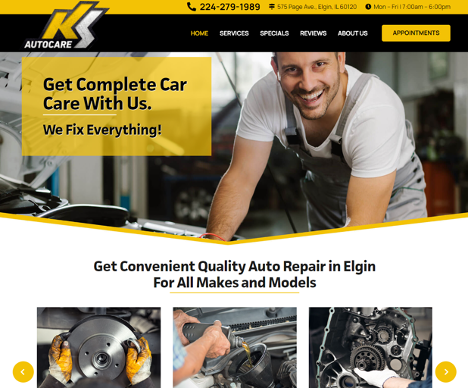
This is a great example of a good auto repair website. It’s easy to navigate, has a modern and clean interface, features smart keyword placements, and has clear calls-to-action.
If your site looks outdated, doesn’t work on a visitor’s mobile phone, or has bugs, that visitor is going to go back to the search engine, and click on your competitors until they find a shop they feel they can trust.
2. Develop A Basic Keyword Strategy
Keywords refer to the phrases that your prospective customers use to search for places, things, and services online at websites like Google and Bing.
For instance, “best auto mechanic in Boston” would be a good keyword for a Boston-based auto mechanic to target, as it’s something their customers are likely to be typing into Google when they have an issue with their car.
There are all kinds of tools and methods to find great keywords to target, but start with your intuition, or by asking around. If you want a more advanced output, you can use Google Keyword Planner, Chat GPT, or Search Engine Optimization tools like Moz or Ahrefs to get more in-depth data.
Once you have these target keywords chosen, you’ll want to make sure that you use them on your website.
Keywords make your content stronger and improve optimization for search engines. This in turn will help your website show up more prominently in Google search results, and earn more auto repair leads.
3. Research Your Competition
After doing your basic keyword research, you’ll want to find out what your competitors are doing online. This will help you see what works, and what doesn’t, within your geographic market.
When you analyze your competitors, be sure to ask yourself the following questions:
- What is my competition doing well with respect to online marketing?
- How active are they on social media?
- Do they have a good blog? A good website?
- Do they produce video content on YouTube?
- Are they targeting specific audiences or customer segments?
By asking (and answering) these questions, you will grow to understand the strength of your competition, and you’ll likely identify some gaps that your business can fill.
4. Write Content For Your Website
When it comes to online marketing, creating and publishing good content on your website (and often elsewhere online) is essential to success.
You’ll want to focus on developing high quality, original, and informative content that is relevant to your customer’s interests. Ideally, you’ll want to become a go-to source for information on auto repair procedures and knowledge in your geographic market.
Try not to think of this content as words on a page. Instead, imagine it’s a bullhorn you can use to broadcast your brand and values.
That said, it’s equally important that your content be well-optimized for search engines and users alike.
That means, make sure your content:
- Is easily scannable
- Stays on-topic
- Focuses on the needs of your audience, and less about your business itself
- Incorporates your Keyword Strategy from Step 1
In a nutshell, content is the backbone of your online marketing strategy so don’t skimp on it. Put in the time, and do it right.
5. Search Engine Optimization
Search Engine Optimization (SEO) is an intimidating aspect of online marketing for most business owners. And you’d be wary for good reason.
Unfortunately, there are far too many bad actors in the digital marketing space, and this is especially true for SEO in particular.
We believe it’s because of the technical nature of SEO work that many consultants and gurus are able to (and willing) to talk hard working business owners under the table, and to obscure basic principles with smoke and mirrors.
Let’s do away with that.
In short, SEO is the process of attempting to improve the positioning of a website in the results for search engines, for specific keywords.
The methods and tactics are indeed technical in nature, though there are some basic principles that any business owner with a website can and should employ.
- Make sure that your target keywords are in your page titles, and meta descriptions.
- For instance “Joe’s Auto Repair | Rated #1 Auto Mechanic in Boston Since 2007” makes for a great, SEO-friendly page title.
- Ensure your website loads quickly, and works on mobile devices.
- Secure your website with HTTPS.
- Make sure you have a Google Business Profile, and that it has the same business name, address, and phone number that you have listed somewhere on your website.
This is just scratching the surface, and we do recommend finding a reputable company to help with the more technical aspects of SEO. But by following the above steps, you’ll be positioned well for improved search rankings on your target keywords from step 1.
Speaking of Google Business Profiles, let’s cover that in greater detail.
6. Create And Optimize Your Google Business Profile
If you don’t already have a Google Business Profile (formerly called Google My Business), this should probably be your first order of business.
Google Business Profiles are a prerequisite to even have a chance to shop up in the top Google Maps Rankings. As you probably know from your own habits, Google Maps is prime real estate that must be prioritized for local businesses.
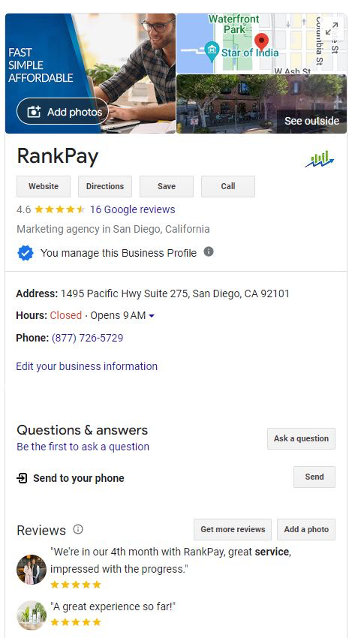
Creating and verifying a profile are the first step. But that’s only the tip of the iceberg.
You’ll also want to fill out the rest of the optional information about your business. Hours, a description, some photos, etc. Put great care into this, it’s worth the time to do it right.
After your profile is completed and verified, it will now always show up in the right side of the search results when someone searches for your business name specifically.
Now you can see why this is critically important!
7. Provide A Good Online User Experience
Search engines and website visitors despise bad user experience.
How many times have you tried to visit a website, only to find that it didn’t load properly on your mobile phone? Or perhaps it didn’t load at all?
What about websites that took 30+ seconds to load? How likely are you to trust the business that owns that website, or want to do business with them?
Most users will have one experience like that, and move right on to the next option in the search results. Don’t be the brand that loses all of those potential cars!
- Check that your website is free of 404 errors.
- Check for broken links.
- Same as in Step 5, make sure your site is mobile-friendly and doesn’t take too long to load.
- Make sure you have smart navigation options for users.
- Give users what they want right away, don’t hide critical information behind pages or popups.
Again, there are lots of usability issues that will require a technical website developer to resolve. But keep these items in mind when deciding if you should budget time or money in order to make progress on usability.
8. Use Google Analytics
Far too often we meet shop owners that don’t even have Google Analytics installed on their websites.
It’s understandable, given that there is never a shortage of things to handle in a busy shop. But it’s a big oversight, because without Google Analytics, you will have no way to understand how users are engaging with your website.
Furthermore, if you do attempt these marketing efforts, or hire a team to do so, you won’t have any way to monitor the results.
Installing Google Analytics is pretty straightforward provided you have website access, or someone on your team does and knows how to do simple work in your website backend.
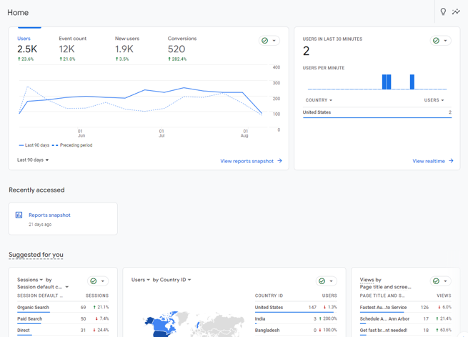
Once you have it installed, take the time to watch a YouTube video, or read some of Google’s own documentation on how to peruse the data available, and how to draw conclusions from what you see.
9. Use Call Tracking
Call tracking technology provides tremendous value to shop owners all over the country. We like it so much that we recommend every shop owner take advantage of it.
Call tracking software uses dynamic number swapping on your website, and allows you to set up unique static phone numbers for channels like Google Business Profiles, mailers, or Google Ads.
Then, whenever someone calls in, the software will be able to tell you where that user came from, and sometimes much more.
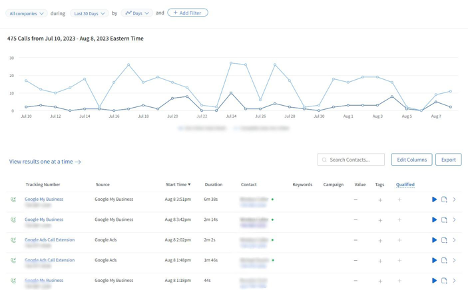
For instance, clicks-to-call from Google Ads (when properly configured with call tracking software) can even show you what ad campaign a user saw, what keyword they searched for, and other key data.
Ultimately, you will be able to look at your calls in aggregate and gauge whether or not the volume is increasing, assess overall lead quality, and even measure marketing channel ROI.
10. Create Social Media Profiles And Post Regularly
To many business owners, this is a frustrating one. We understand of course.
Taking the time to post on social media is hard even on a slow day. But when there are folks in the waiting room and your technicians are struggling to keep up with a rush of cars, it can feel impossible.
Fortunately, social media for auto repair companies typically doesn’t need to be very involved. Visitors may just check out your Facebook page to see if you’re active, or to look at some of the cars you’ve worked on.
They generally want to know what kind of environment they’re going to be walking into, and what kind of care you bring to your work.
Bare minimum, once a week, take a photo (with your customer’s permission of course) of a car being worked on. Describe the job. Talk about the before and after maybe, or how you solved a unique problem.
These types of posts serve as great trust signals to visitors, and also keep your profiles active and healthy.
11. Collect Reviews
In addition to having a Google Business Profile, you’ll want to make sure to collect reviews for this profile.
Prospective customers are quick to judge businesses based on the reviews they see for them online, especially on their Google Business Profiles.
There are all kinds of ways you can go about requesting reviews from your customers. Some of the most common and popular methods are requesting it via email a day after service appointments, or asking for a review in person right after you close a transaction with a customer via an NFC card/placard you can have on your front desk.
Ultimately, no matter how you go about it, requesting and building a portfolio of reviews will have a huge impact on your ability to earn more customers online.
12. Take Advantage of Google Ads
Many years ago, Google Ads themselves were quite limited with respect to how much space they took up in the search results. Furthermore, users were wary to click ads, and generally avoided them.
Today, Google has significantly emphasized the prominence of ads in almost all search results. And in lock-step, general engagement with Ads in the search results page has increased over the years.
Now, there are 2-3 lengthy ads at the top, there are ads in the Map Pack, and there are ads at the bottom of the page. For other search result types that may include products or other features, there can be even more ads before you see any organic results!
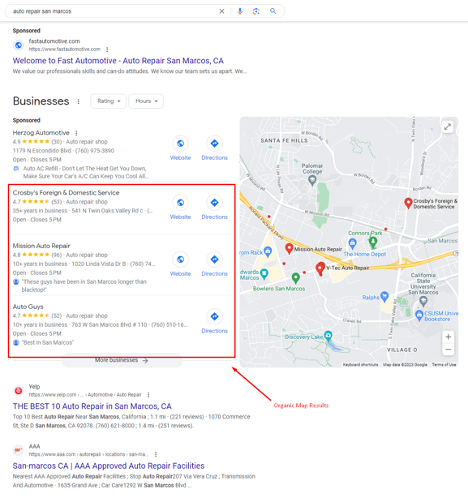
Because of this and some other factors, we generally advocate that shop owners invest in Google Ads for at least a 60 day trial run to see what kind of ROI can be generated in their specific market.
When leveraged by an experienced strategist or expert, this channel can be fine-tuned to only gather the most qualified leads, and drive them to call and schedule an appointment.
Closing Thoughts
With time and energy, these tactics will work! We know they do. We have years of data to back it up.
The playbook above, is quite literally the program we employ to help auto repair business owners across the country get their phone ringing. And we developed this strategy precisely because we’ve had years of trial and error to learn what really works.
If you want to grow your auto repair business through online marketing, feel free to reach out to us today. We’d be happy to provide you with a free consultation, answer any questions you might have, and develop a marketing plan customized to your specific geography and shop needs.
